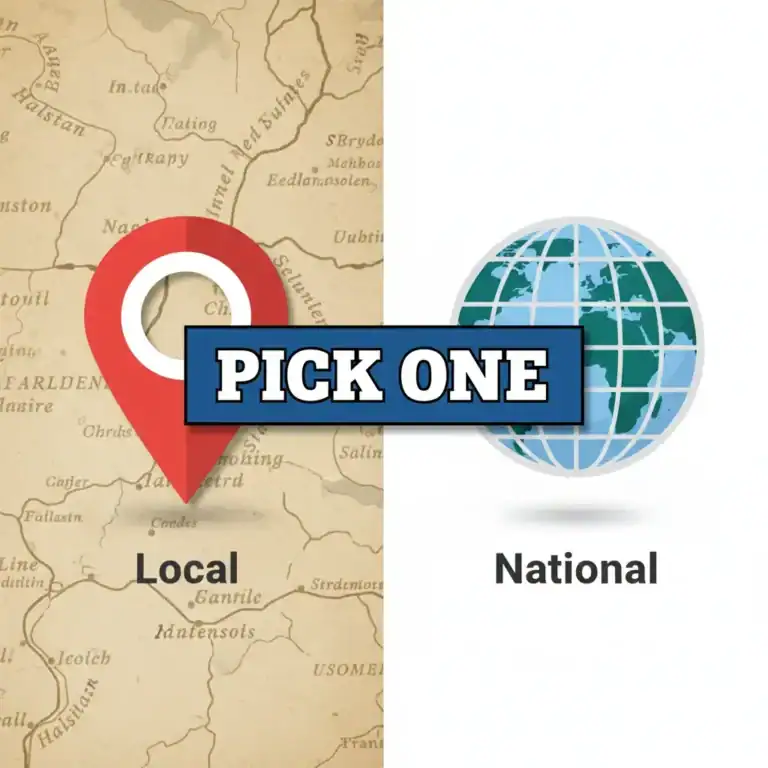
Local vs national SEO for MSPs is not a philosophical question. It’s a capacity and pipeline question. Choose one scope for 90 days, ship the right pages and proof, and measure progress on a short weekly view. Pick both, and you’ll split focus, under‑deliver, and stall. (We see this in Diagnose often.)
Local = Map Pack first. You serve a defined metro or radius. Success is characterized by increased calls, site clicks, and messages from your Google Business Profile (GBP), alongside steady growth in organic sessions to service and city pages. Your north stars: actions per 1,000 views, revenue‑page conversion rate, and speed‑to‑lead on mobile.
National = category visibility. You sell to multi‑metro or national buyers. Success looks like growth on category and comparison terms (e.g., “co‑managed IT pricing”), links from relevant publications, and conversions on category & pricing content. Your north stars: non‑brand share on priority queries, referring domains, and bottom‑of‑funnel page conversion.
Whatever you choose, plug the plan into your monthly Growth Engine cadence so wins compound.
Our checklists hammer this point: choose one scope and avoid hybrids in the first 90 days.
Week 1: Fix the Google Business Profile basics. Clean name, correct categories, real service area, updated photos. Point both “Website” and “Appointment” to the best‑match service or city page with UTM parameters so you can see what turns into leads.
Week 2: Publish or repair your top two service + city pages. Above the fold: plain‑English value, proof, and one primary CTA. Repeat the CTA at the bottom. Add a short FAQ near the CTA to answer common buying questions quickly. See patterns in Website Design & Optimization.
Week 3: Speed and stability on phones. Aim for a ~≤2.5s first meaningful interaction on revenue templates and no layout shift. Sanity‑check with PageSpeed Insights.
Week 4: Reviews and routing. Turn on a simple, compliant review engine tied to positive moments. Ensure that new calls, forms, and scheduler bookings are routed to a human within minutes. Wire alerts via your Marketing Automation stack.
Month 2–3: Add the next two city pages, tighten internal links from related posts, and build a small set of relevant citations and local links. Track actions per 1,000 views, sessions to your service + city pages, and meeting rate by source in Reporting & Analytics.
Week 1: Lock the category set (e.g., MSP services, co‑managed IT, Microsoft 365) and decide two “win first” terms. Draft outlines for category pages and one comparison or “alternatives” page. Avoid programmatic boilerplate; depth wins.
Week 2: Publish category pages with clear differentiators, scannable sections, and bottom‑of‑funnel CTAs. Add a “How pricing works” explainer with ranges and factors. Tie these to the right content assets and case vignettes.
Week 3: Answer boxes and AI surfaces. Add concise FAQs (≤120 words each) and structured data where relevant. Target a few bottom‑funnel queries for featured snippets and keep answers quotable for AI/answer units. This is part of Zero‑Click Influence.
Week 4: Links and proof. Ship two earned‑link assets (original data, case compilation, or detailed process explainer) and pitch relevant industry or local publications. Keep author bios, address, and credentials visible to strengthen E‑E‑A‑T signals.
Trying to build city pages and national category authority simultaneously is a classic stall. Our Diagnose checklist literally starts with “Choose one scope; no hybrids.” Do one well, then stack the other into your next 90‑day plan.
Local: GBP actions/1,000 views; organic sessions to service + city pages; revenue‑page conversion; median speed‑to‑lead.
National: Non‑brand impression share for priority terms; referring domains; category/pricing page conversion; meetings from Organic.
Keep these on a one‑page weekly view with owners and acceptance criteria. It’s the same format we use in the Stabilize & Strategize report.
If you want help choosing scope and shipping the first set of wins, run a 30‑day triage: Diagnose the leaks, Stabilize measurement and pages, then Strategize the 30/60/90 plan. After that, transition into your Growth Engine cadence to ensure gains stick and scale.
Related pillars: Local or National SEO • Website • Zero‑Click Influence • Reporting & Analytics
Pick a scope, fix the leaks, and prove lift in 30 days.
Match scope to how you sell. If 80%+ of customers come from one metro and you can answer local calls fast, choose Local. If you sell across markets and have category proof that travels, choose National. Commit for 90 days before switching scope so you can ship the right pages, proof, and tracking—and actually measure lift.
Not in the first 90 days. Splitting focus slows results and hides what’s working. Pick one scope, ship the pages and proof that fit it, and review a simple weekly dashboard. Add the other scope in the next 90‑day plan once your first wins are stable.
Fix Google Business Profile and point “Website/Appointment” to the best‑match service or city page with UTMs. Publish unique service + city pages (no boilerplate), place proof near the CTA, and add a short FAQ block. Track actions per 1,000 views, sessions to those pages, and speed‑to‑lead.
Publish category pages that show differentiators, a comparison/alternatives page to capture evaluators, and a concise pricing explainer. Add FAQs and valid schema to win answer units/AI surfaces, and support with earned links from relevant publications.